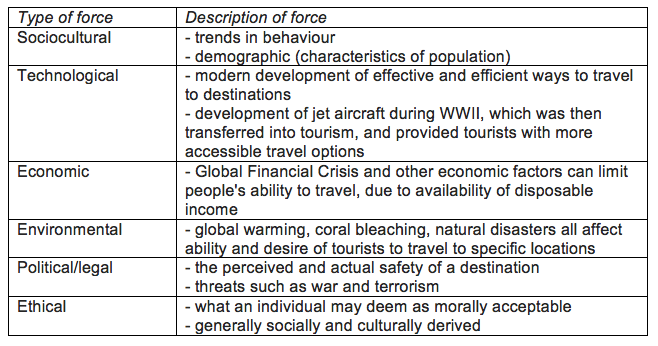| An Introduction To Tourism |
|
MACRO FORCES FOR TOURISM CHANGES
Evolution and growth of tourism as an industry
It can be argued that modern tourism began on 5th July 1841 in North Britain, when Thomas Cook conducted the first excursion train (Hall, 2007). However, there are many cultural and technological advancements since that have contributed to the rise in recreational tourism.
The development of transport and technology can be directly linked to the evolution of tourism in Australia (Hall, 2007), especially railway lines and horse-driven coaches. The production and promotion of major exhibitions, such as the World Fair, also contributed to the tourism boom, as they attracted both national and international tourists.
Technological advances during World War II saw the development of the jet aircraft, which reduced transit time, increased accessibility and increased the mobility of tourists. The leisure boom that followed the war was fueled by increased discretionary time and income, combined with more mobility due to private cars.
Cultural changes that occurred during the 1960s also lead to a change in tourism (Hall, 2007). Beachwear was deemed acceptable and tans became fashionable, fueling an increase in beach and resort tourism.
Increased discretionary time to travel and increased mobility can be argued to be the two largest factors which have fueled the boom in modern tourism.
The development of transport and technology can be directly linked to the evolution of tourism in Australia (Hall, 2007), especially railway lines and horse-driven coaches. The production and promotion of major exhibitions, such as the World Fair, also contributed to the tourism boom, as they attracted both national and international tourists.
Technological advances during World War II saw the development of the jet aircraft, which reduced transit time, increased accessibility and increased the mobility of tourists. The leisure boom that followed the war was fueled by increased discretionary time and income, combined with more mobility due to private cars.
Cultural changes that occurred during the 1960s also lead to a change in tourism (Hall, 2007). Beachwear was deemed acceptable and tans became fashionable, fueling an increase in beach and resort tourism.
Increased discretionary time to travel and increased mobility can be argued to be the two largest factors which have fueled the boom in modern tourism.
Macro forces that influence the historic and future demand for tourism
Table 8 shows the macro forces that influence the historic and future demand for tourism. These will be displayed by the type of force and descriptions and examples of each. This was derived from reviewing credible literature.
Table 8: Macro forces that influence the historic and future demand for tourism
Table 8: Macro forces that influence the historic and future demand for tourism
Source: Hall (2007); Evans, Campbell, & Stonehouse (2003).
Key points of the table:
- there are six main macro forces that influence demand for tourism
- one or more force(s) can affect a tourist's motivations to visit a destination
Key points of the table:
- there are six main macro forces that influence demand for tourism
- one or more force(s) can affect a tourist's motivations to visit a destination

